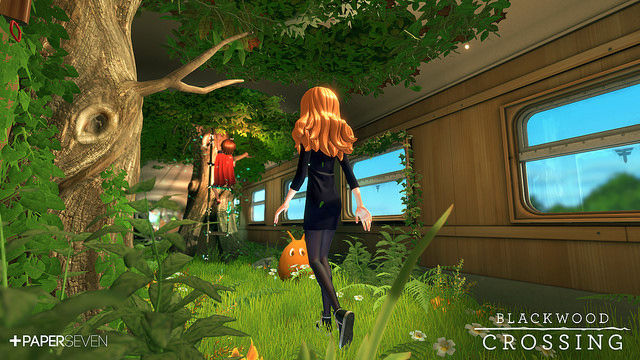Reflecting on the early prototype of "Loftus"
- Trevor Barry

- Dec 28, 2017
- 6 min read
I am now going to discuss the development stages of my game “Loftus”. This process all began at the start of the semester when we needed to pitch an idea for a game. I was highly inspired to create a narrative game thanks to the games I played during the summer holidays. Games like What Remains of Edith Finch which tells the story of the Finch family who are seemingly victim of a mysterious curse.

Blackwood Crossing which tells the story of a brother and sister travelling on a train and deals with very serious issues such as their parent’s death.

But I was very inspired by the game “The Town of Light” which tells the story of a mental institute situated in the Italian mountains. The player explores this game by walking through the now abandoned institute and you uncover real patient notes, personal items and stories of the patients that really habituated this place during the 40’s.

With this in mind I came up with the idea for “Loftus”. This game is based on Loftus Hall Co.Wexford. This was an old house that I passed by one my summer holidays a few years ago and the image and location of the house stayed with me for years.

Once I heard the story of Anne Tottenham and the stranger I knew this was a story I wanted to explore in a game. Anne Tottenham’s family welcomed in a stranger who was shipwrecked nearby. When this stranger and her family played cards, one of the cards fell on the floor. When Anne went to pick this card up she saw the stranger had cloven feet. When she confronted the stranger about this he burst into flames and went through the ceiling. It turned out that this stranger was in fact, the devil.
I started out the level design for this game by going into Unity and designing the exterior of the house. I was inspired by the real-life location which is at least several hundred yards away from the main road. I intentionally wanted a long driveway so I could add some narrative to the beginning of the game and having nothing in the way of the player, all the attention of the player would be focused on the narrative.
The next stage was to make a layout of the interior of Loftus Hall. The real-life hall only has two floors so my prototype had a ground floor and a first floor. The very beginning of the interior scene has the most distinct feature of the house from the very beginning, this is the staircase. I initially drew the layout I wanted on paper and then I set about creating it using the wall prefab in the standard assets folder. If I could go back I would have used something else because I never realised only the front plane of the wall is visible. So if you stand next to it the wall looks flat. If I could go back I would just use a cube and scale it to the size of wall I wanted. Once I had this done I set about creating the staircase by slowly but surely adding a stair prefab 3 times by using the scale tool. I then used the platform tool for the banister of the staircase. Once I had this finished I added a further layout of the first floor.
After I had these done I gave my first thought of the cognitive flow. I took a step back from my game and I found there was nothing really exciting about my game. You as the player are just walking around an empty space. That’s just not entertaining at all. So I decided to introduce three mechanics to my game to increase the players interest in my game. I decided to increase the challenge so I could hit the perfect mid-ground of cognitive flow by being not too easy and not too hard.
The first mechanic I introduced into my game level is the note mechanic. Notes provide two things for the player. First of all, this encourages the player to explore the house to uncover as many notes as possible. Secondly these notes contain personal letters that are written by me based on real life stories that I stumbled on during my research of the house. This helps the player build empathy towards the occupants of the house and also provides some clues as to how to unlock the door to advance to the next level of the game.
The second mechanic is similar to the note mechanic and that is the use of projectors. These are interactable objects which project old film onto the wall showing story relating to the house. This again helps teach the player about the house and its inhabitants.
The third mechanic is the introduction of the Enemy AI. The player must avoid this enemy if they want to live to tell their tale of the house. I plan to further show this by introducing household items like cupboards where the player must go to avoid the enemy AI. I introduced this enemy with cognitive flow in mind. I believe this adds a level of challenge to the game and will take the player by surprise because normally this genre of game does not have any enemies in it.
I feel like I used at least 7/10 principles of level design in the opening level for Loftus:
1. The player should always know exactly where to go. My game takes place in a confined space leaving the player with not a lot of options on where they can go. The same can be said for the outdoor scene. You will be able to see a lot of landscape etc. but you will never be able to go there. The level I have created is very streamlined.
2. Good Level design does not rely on words to tell the story
My game is definitely explicit and to a smaller degree implicit in its storytelling. The storytelling is explicit because a lot of the story is told via notes and projections. Because I am creating a narrative game the story has to be told in a very easy and digestible way.
But I would say there is a little bit of room for implicit story in there. The player may choose to not believe anything I write and interpret the story in their own way. Some of the stories I came across challenge our belief in what is real and what is legend. I think many people will make up their own stories and interpretations as to what the game is about.
3. Good Level Design Tells What but not How
I believe my game encourages improvisation because it is totally possible if the player finds the keypad at the back of the ground floor early and try inputting numbers they see they may complete the level without going upstairs and being challenged by the enemy AI. I don’t force the player to go upstairs if they don’t want to.
4. Good level design constantly teaches May game I believe finds new ways to teach the player at all times. Firstly the layout of the level does this. The ground level provides a safe space to discover notes and projectors. This encourages the player to look for these throughout the house.
The second level provides another thing to teach the player, I introduce enemy AI. I hope this takes the player by surprise and they must find a new way to learn and adapt how to avoid this enemy AI.
5. Good Level Design is Surprising
I believe the introduction of an enemy AI will be very surprising to the player. This is something that is very rarely seen in the narrative genre.
6. Good Level Design Empowers the Player I believe my game encourages the player to experience escapism in the game world. Also the player can use their detective skills to uncover the story and I believe this will give them a sense of achievement in what they uncovered.
7. Good Level Design Creates Emotion
Because the stories in my game are based on real life I believe this will create empathy from the player towards the characters in the game.



Comments